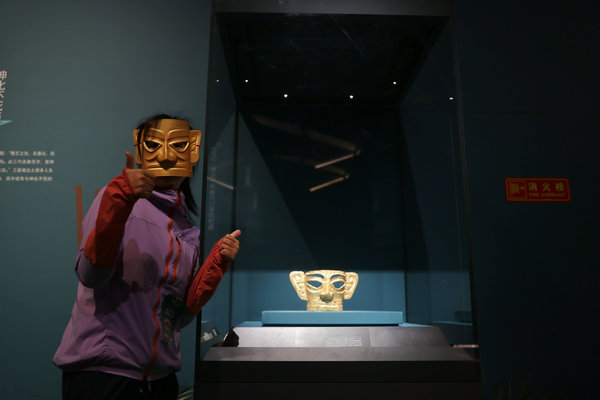

Scorching weather and its location far from downtown Beijing are not proving to be obstacles to people's enthusiasm for admiring the brilliance of ancient cultures.
Over the last two weekends, visitors have had to stand in long lines for hours on end to enter the Capital Museum East Branch to see artifacts from remarkable Bronze Age civilizations that flourished over 3,000 years in present-day Sichuan province.
The widely anticipated exhibition, Unveiling Sanxingdui and Jinsha of Ancient Shu Civilization, which opened on June 27 and which will run through to Oct 10, has placed 265 artifacts on display and shows the efforts over the last century to decode a distant past.
The Sanxingdui site in Guanghan was discovered in the 1920s, but what really amazed the world was the milestone 1986 discovery of two pits, presumably used for sacrificial ceremonies. Exotic-looking bronze masks, statues and gold artifacts ushered people into a world full of romance and imagination. The Jinsha site, discovered in 2001 in the provincial capital of Chengdu, is famed for its exquisite bronze, jade, stone relics and numerous ivory tusks.
Thanks to the two sites, ancient Shu civilization was able to emerge from mythology and literature to yield its treasures and character.
"Through tireless exploration and the generational efforts of archaeologists, the image of ancient Shu civilization, represented by the Sanxingdui and Jinsha cultures, is becoming increasingly clear," says Gao Hongqing, curator of the exhibition.
Nevertheless, the open-ended explanations on the artifacts on display demonstrate that the ongoing exploration of ancient Shu civilization still has a way to go.
As the bronze masks, human figures with protruding eyes, bronze wheel, and gold scepter on display show, the groundbreaking 1986 discovery at Sanxingdui leaves many issues unanswered. A new round of excavations between 2020 and 2022, which revealed six more "sacrificial pits", raised even more questions.
Tang Fei, deputy director of the Sichuan Provincial Cultural Relics and Archaeology Research Institute, says that about 60 of the exhibits in the ongoing display come from this new round of excavation, which led to the unearthing of more than 17,000 artifacts, including 4,800 that were mostly intact.